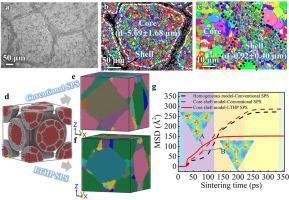The coupling efficacy of sintering temperature and pressure assistant densification of core-shell structured pure Ti
IF 6.6
2区 材料科学
Q1 MATERIALS SCIENCE, MULTIDISCIPLINARY
Journal of Materials Research and Technology-Jmr&t
Pub Date : 2025-09-19
DOI:10.1016/j.jmrt.2025.09.180
引用次数: 0
Abstract
The densification behavior of core-shell structures under low-temperature high-pressure (LTHP) spark plasma sintering (SPS) is rarely revealed. Therefore, this study successfully achieved dense core-shell structured Ti through LTHP SPS, and investigated the coupling influence of temperature-pressure on densification behavior using molecular dynamics simulations. Experimental results indicate that 600 °C/400 MPa represents the optimal LTHP SPS condition for preparing dense core-shell structured Ti bulk without excessive grain growth. This inhibition of grain growth is attributed to the distinct densification behavior of LTHP SPS compared with conventional SPS method. Specifically, under conventional SPS, densification primarily occurs during the heating and holding stages, with plastic flow involved in initial heating stage transitioning to atomic diffusion driven by high temperatures dominating the subsequent sintering process. In contrast, LTHP SPS exerts a more pronounced effect on densification during the heating stage, where plastic flow is the dominant mechanism, accompanied by limited atomic diffusion due to lower temperatures. Entering the holding stage, plastic flow, atomic diffusion, and atomic migration all contribute to mild densification. Cooling predominantly involves atomic oscillations. This study not only provides critical insight into the densification mechanisms of LTHP SPS but also offers significant guidance on obtaining dense heterostructural metals by LTHP SPS technology.

烧结温度和压力对纯钛核壳结构致密化的耦合效应
低温高压(LTHP)放电等离子烧结(SPS)下核壳结构的致密化行为很少被揭示。因此,本研究通过LTHP SPS成功制备了致密的核壳结构Ti,并利用分子动力学模拟研究了温度-压力对致密化行为的耦合影响。实验结果表明,600°C/400 MPa是制备致密核壳结构Ti块体的最佳LTHP SPS条件,且没有过度的晶粒生长。这种抑制晶粒生长的作用是由于LTHP SPS与传统SPS相比具有明显的致密化行为。具体而言,在常规SPS下,致密化主要发生在加热和保温阶段,初始加热阶段的塑性流动转变为高温驱动的原子扩散,主导随后的烧结过程。相比之下,LTHP SPS对加热阶段致密化的影响更为明显,在加热阶段,塑性流动是主要机制,同时由于温度较低,原子扩散有限。进入保温阶段,塑性流动、原子扩散和原子迁移都有助于轻度致密化。冷却主要涉及原子振荡。该研究不仅对LTHP SPS的致密化机制提供了重要的见解,而且对利用LTHP SPS技术获得致密异质结构金属具有重要的指导意义。
本文章由计算机程序翻译,如有差异,请以英文原文为准。
求助全文
约1分钟内获得全文
求助全文
来源期刊

Journal of Materials Research and Technology-Jmr&t
Materials Science-Metals and Alloys
CiteScore
8.80
自引率
9.40%
发文量
1877
审稿时长
35 days
期刊介绍:
The Journal of Materials Research and Technology is a publication of ABM - Brazilian Metallurgical, Materials and Mining Association - and publishes four issues per year also with a free version online (www.jmrt.com.br). The journal provides an international medium for the publication of theoretical and experimental studies related to Metallurgy, Materials and Minerals research and technology. Appropriate submissions to the Journal of Materials Research and Technology should include scientific and/or engineering factors which affect processes and products in the Metallurgy, Materials and Mining areas.
 求助内容:
求助内容: 应助结果提醒方式:
应助结果提醒方式:


